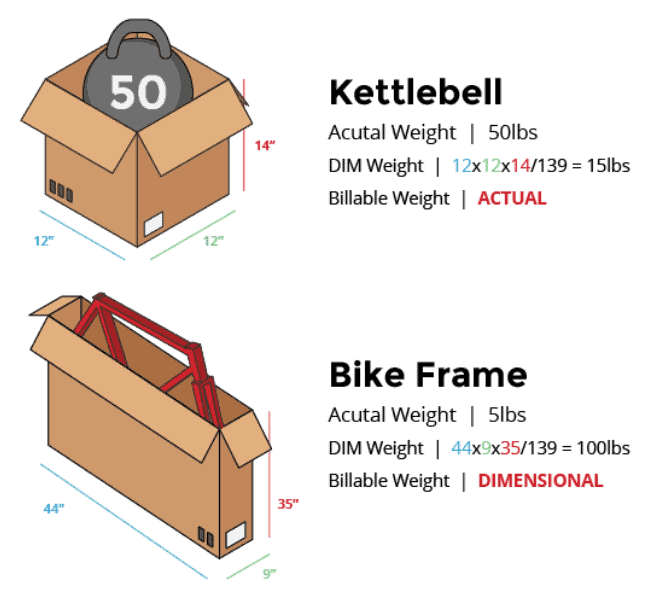Learning how to calculate shipping costs can be some of the trickiest to get a handle on for eCommerce businesses that want to balance customer satisfaction with affordability and margin control. The vast majority of your customers expect shipping to be fast and usually free. To meet those demands, you’ve got to be able to predict shipping costs so you can adequately cover them.
This guide is designed to help you understand the basics of shipping pricing, offer links to the leading U.S. carriers to explore differences, and see where your eCommerce tools or third-party solutions can make life easier. Logistics costs can be managed and simplified when you have the right partners and support.
Understanding your shipping costs and preparing your business to address them starts with knowing how carriers charge to move your orders. While the basic principles have remained the same across the years — go farther, pay more — there are new considerations, challenges, and opportunities you should know.
Let’s dive in and start by understanding what impacts the baseline price.
5 standard factors to help calculate shipping costs
Shipping for your orders is going to vary if you have a large number of SKUs. The mix of products inside will determine the size and weight of the package(s) used, and those determine cost calculations for carriers. In general, five metrics will determine your price and what to pay attention to as you calculate shipping costs.
1. Full package weight
The most traditional cost factor for a package or parcel is its weight. Every carrier will calculate a cost specific to the weight of your box (unless you use a flat-rate option), and the heavier it is, the more you’re likely to pay. However, weight is just one of the two primary cost metrics.
2. Package dimensions
The size of your package is the second chief variable for the cost of your package. Most carriers now calculate one price based on weight and a second based on “dimensional weight,” or DIM weight. DIM weight looks at the volume of space your package takes up and generally involves more sophisticated math from carriers — we’ve got a more detailed explanation and a DIM weight calculator below to help you out.
3. Destination zones
The location you ship from and the final destination of your package also impact how much you’ll pay for each shipment. Each carrier has its own shipping zones that it uses to classify distance traveled from the point of origin. Each zone comes with its own cost, and the higher the zone, the more it’ll cost.
For example, FedEx zones correlate to distance like this:
| Zone | Miles from the point of origin to the delivery address |
| 2 | 0-150 |
| 3 | 151-300 |
| 4 | 301-600 |
| 5 | 601-1,000 |
| 6 | 1,001-1,400 |
| 7 | 1,401-1,800 |
| 8 | 1,801 or more within the contiguous U.S. |
Note that in many cases, a ZIP code will serve as a proxy for distance, so you may be paying for slightly more or less distance that it travels.
What shipping zones can teach us is that you might be able to save significantly if you move your distribution facilities closer to your most common customer locations. In some cases, that reduces expenses enough to make additional shipping locations a cost-saver. It’s one big reason Red Stag Fulfillment offers two fulfillment locations to all of our clients.
4. Delivery speed
How fast you want your packages delivered also impacts how you calculate shipping costs. Your delivery speed usually has one of two options, delivery by a defined date or specific shipping method that comes with a range of potential delivery days.
Guaranteed shipping will let you know when something will arrive by, such as next-day and two-day shipping options. These methods make it easy for you and your customers to predict when something will arrive. Such options are usually more expensive, and the cost increases the further goods travel. So, next-day shipping to Zone 3 will be cheaper than next-day shipping to Zone 7.
Standard ground shipping will generally offer you a lower price because it not only can take a longer time, but you get a range of days instead of a specific date. USPS’s Retail Ground shipping, for example, says it can take between 2 and 8 business days to reach customers depending on the shipping zone. However, if you ship this on a Friday, it potentially can take as many as 12 days total to reach a customer because of weekends. Thankfully, that’s a rarity, and packages sent out as far as Zone 8 or 9 will average about five business days.
So, delivery speed is one area where some eCommerce businesses can start to think about saving.
5. Insurance and add-ons
Specific requests you make about a package can increase your final result when you calculate shipping costs. The most common one for an eCommerce business is securing shipping insurance to protect against damage or loss during shipment. While most shipments arrive safe and intact, shipping insurance is generally recommended because it can make it much more affordable to replace expensive or high-value products.
You can purchase shipping insurance directly through your carrier, though some eCommerce platforms also allow you to buy third-party insurance. It’s a smart idea to price shop these and reach out to partners like Red Stag for a better understanding of the insurance process and value.
There are also fees when you want or need specific delivery options, such as signatures. FedEx, for instance, charges $6.35 or more for a package that requires an adult signature. Any unique requirements you have for a package can impact cost significantly, so ensure that your price comparisons include all of the options and features you need for a shipment.
Shipping calculators for major carriers
The major carriers all have specific shipping estimation tools to help you calculate shipping costs. They’re available on each carrier’s website, and we’ve got them plus a little explanation below. But before you dive right in, there’s one crucial thing to know: those aren’t the best rates you can get.
3PLs like Red Stag Fulfillment can negotiate better carrier rates because we ship large volumes of packages with the three big U.S. carriers. They want to get as much of our business as possible, so they offer discounts, and we pass those savings along to customers like you. By pairing that with our custom boxes and packaging techniques, we may be able to decrease your costs substantially.
If you’re not ready for a full fulfillment and shipping partner — whether that’s because of your size or you enjoy running your own warehouse — we also recommend that eCommerce companies look for apps and plugins specific to your eCommerce platform. Some services integrate with the leading tools out there and can automate much of your shipping selection. It’s somewhat limited because you will need to populate size, weight, and other elements for each order, but can help you choose the right carrier for your most common shipments.
Review any software and plugins you regularly use to ensure that they’re working correctly and giving you the best rate. Some have excellent ratings on platform app stores, while others are mixed. We use a combination of automation and verification tools to ensure our customers always get the best choice based on price, speed, location, and order.
Now, here are tools to help you calculate shipping costs with the most common U.S. carriers:
- USPS: The Postal Service offers you two shipping calculators for domestic mail and business customers. You’ll often find the cheapest rates here because of how much mail USPS already delivers and the places they go. It’s worth applying for the commercial pricing if you meet the minimum quantity amounts because of the significant discounts you get and the mix of free services.
- UPS: UPS gives you a few different shipping options, and you can compare standard and expedited shipping with this calculator here. If you’re thinking about using its freight service, this calculator makes it simple to understand time and cost. The service does offer a variety of small business options and discounts. The small business program has different names in different countries, and it may push you to some outside services, such as ConnectShip, a wholly-owned, independent subsidiary of UPS that provides multi-carrier tools.
- FedEx: As the other carriers mentioned, there is a FedEx Small Business service that can provide you with some discounts if you meet some of its volume and other requirements. It’s worth trying for new members because you can save 20% on ground shipments and up to 40% on some select Express shipments. (The biggest discounts are for freight and returns services). If not, use their standard rate finder tool to test traditional packages, and freight options — logging into your account will also let you use that rate finder service to see pricing with your discount.
Saving money when you calculate shipping costs
Now that you’ve got a handle on the basics let’s dive a little deeper on a few elements that are important for eCommerce businesses to consider for understanding and reducing costs.
Cost Understanding: Dimensional weight calculations
Dimensional weight, or DIM weight, is a formula that carriers like the USPS, UPS, and FedEx will use to look at the size of the packages you ship to see if they should be priced differently. They’re looking at size and weight because those are the two biggest factors for their costs and capability. A truck, van, or aircraft only has so much room and can only carry so much weight.
To price you appropriately for how much you take up of either the allocated weight or space, these carriers calculate one rate based on box dimensions and another on the weight of the parcel. You get to pay whichever is higher.
We’ve got a working DIM weight calculator for you to try here to test and see what pricing you might face. We keep it updated with the latest DIM weight calculations so you can get a reliable estimate for these three carriers.
In most cases, heavy objects are going to be priced by weight, and you’ve got no great way to adapt to this. However, if you’re selling lightweight goods, then running DIM weight calculations may help you think of new ways to ship to your customers.
DIM weight calculate shipping costs example

For example, let’s say that the titanium bike frame comes in two pieces. You may be able to keep it separate and ship each part in its own box. If you can reduce the box size enough, those two packages could have a lower shipping cost than just one larger package.
We’ve seen it happen and helped customers find innovative approaches just like this. Get in touch, and we’ll talk about your goods and what might be able to help.
Potential Savings: Calculate shipping costs with flat-rate options
Some eCommerce businesses are better able to control and predict costs by packaging goods in a way that fits into a standard flat-rate shipping box. Many small businesses and eCommerce startups first work with flat-rate options because they can be a fantastic way to manage cost.
There’s a tradeoff with this service from USPS, so let’s look at the pros and cons briefly.
Pros
- Free boxes and known costs
- Automatic insurance covering up to $50
- Many distinct sizes and price options
- USPS has added specialty boxes too, such as a “board game box”
- Standard sizing makes it easy to repeat the amount of filler and other extras
- Automatically includes tracking numbers
- No surcharges for elements such as residential or Saturday delivery
- Counted as Priority Mail for speed purposes
Cons
- Using your own boxes can be cheaper if flat-rate boxes are leaving a lot of extra room around products
- Large flat rate boxes are too small for many long products (internal dimensions are 12″ x 12″ x 5 1/2″)
- Many smaller boxes are not large enough to fit multiple products
- Limited to 70 pounds
- The packaging is branded as USPS, instead of your company
- Can be more expensive than other carriers or postal options (like regional boxes and priority mail) for lighter packages
FedEx and UPS also offer flat-rate options, though these are trickier for determining what’s a bigger cost-saver, and typically include some fees such as one for scheduling a pick up at your business.
Potential Savings: Don’t ignore your freight shipments
When most eCommerce businesses start looking at controlling shipment costs, they focus on getting orders to customers. That’s the perfect place to begin, but it isn’t the end of your journey. You likely are already paying other shipping costs to get bulk orders and freight shipments sent to your warehouse.
There are optimization elements to consider in these shipments, too. Carriers have different freight requirements, but when you’re shipping products in bulk on pallets, you can save significantly compared to shipping boxes individually. When you work with a company like Red Stag, we can accept and hold large inventory quantities – that means freight shipping to our distribution centers. We break down pallets and get your products ready for individual sales, helping you make the most of freight options.
Our experts are available to discuss how best to optimize your inventory and assist with demand planning so that you always have the right amount for your orders. There’s no need to overspend or get surprised by a lack of inventory ever again.
Potential Savings: Discounts Red Stag can secure
While we work with all kinds of companies, Red Stag’s experts specialize in helping customers with large and bulky items as well as heavy products. Because we move a high volume of these goods each day, carriers work with us and provide better rates on what we ship. This includes more favorable DIM factors, and those savings get passed on to you.
Our volume also helps us negotiate better pricing for packages of all other shapes and sizes. So, we can be a significant cost-saver for eCommerce businesses when you consider carrier price reductions, labor savings, and our guarantees for protecting your products and delivering them correctly, on-time every time.
How Red Stag can help you calculate shipping costs
We know that’s a lot of information to throw at you. Unfortunately, small business logistics – even just for shipping and fulfillment – is a complicated matter. There are plenty of opportunities to save and ways to adjust shipments to optimize your spend, but it takes time and expertise to get there.
That’s one big reason Red Stag Fulfillment works with small businesses to find the right 3PL partner. You want to focus on running your business and growing those sales, not taping up boxes, and testing carrier plugins. So, our fulfillment services are designed to get you the best rates and keep your products moving quickly to people without any significant headache or heavy lifting.
We integrate with your online store and manage the full process for you.
Here’s what Red Stag Fulfillment looks like:
- Fully integrated eCommerce fulfillment
- Same-day shipping and fulfillment services
- 100% order accuracy and on-time processing guarantees
- Reach 96% of Americans within 1-2 days
- Automated order fulfillment and carrier selection
- Faster order and return processing
- Lower storage fees
- Packaging consolidation that can save you up to 22%
- Inventory optimization and analytics support
- Significant reduction in monthly inventory loss and damage compared to in-house fulfillment
- Advanced support for kiting and subscription services to help grow your business
If that sounds like something that can help your business, why not try us free for 30 days?









